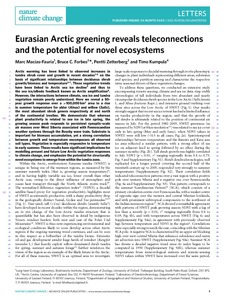Eurasian Arctic greening reveals teleconnections and the potential for novel ecosystems
Macias-Fauria, Marc; Forbes, Bruce C.; Zetterberg, Pentti; Kumpula, Timo (2012)
Macias-Fauria, Marc
Forbes, Bruce C.
Zetterberg, Pentti
Kumpula, Timo
Nature Publishing Group
2012
Macias-Fauria, Marc, Forbes, Bruce C., Zetterberg, Pentti & Kumpula, Timo (2012). Eurasian Arctic greening reveals teleconnections and the potential for structurally novel ecosystems. Nature Climate Change 2 (2012) : 8, p. 613-618.
openAccess
Julkaisun pysyvä osoite on
https://urn.fi/URN:NBN:fi:ula-201211141252
https://urn.fi/URN:NBN:fi:ula-201211141252
Tiivistelmä
Arctic warming has been linked to observed increases in tundra shrub cover and growth in recent decades on the basis of significant relationships between deciduous shrub growth/biomass and temperature. These vegetation trends have been linked to Arctic sea ice decline and thus to the sea ice/albedo feedback known as Arctic amplification. However, the interactions between climate, sea ice and tundra vegetation remain poorly understood. Here we reveal a 50- year growth response over a >100,000 km2 area to a rise in summer temperature for alder (Alnus) and willow (Salix), the most abundant shrub genera respectively at and north of the continental treeline. We demonstrate that whereas plant productivity is related to sea ice in late spring, the growing season peak responds to persistent synoptic-scale air masses over West Siberia associated with Fennoscandian weather systems through the Rossby wave train. Substrate is important for biomass accumulation, yet a strong correlation between growth and temperature encompasses all observed soil types. Vegetation is especially responsive to temperature in early summer. These results have significant implications for modelling present and future Low Arctic vegetation responses to climate change, and emphasize the potential for structurally novel ecosystems to emerge fromwithin the tundra zone.
Kokoelmat
- Artikkelit [455]
